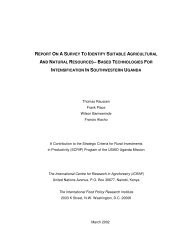Continuities in environmental narratives, Kabale, Uganda ... - Foodnet
Continuities in environmental narratives, Kabale, Uganda ... - Foodnet
Continuities in environmental narratives, Kabale, Uganda ... - Foodnet
You also want an ePaper? Increase the reach of your titles
YUMPU automatically turns print PDFs into web optimized ePapers that Google loves.
early colonial times.’ 8 This article will do just that, trac<strong>in</strong>g how the idea of <strong>Kabale</strong> on the edge of<br />
crisis developed from the 1920s and 1930s with the earliest colonial encounters with the district. 9<br />
The colonial legacy of <strong>environmental</strong> assumptions and <strong>narratives</strong> has been <strong>in</strong>herited by the post<br />
Independence government, and donor agencies have also ‘jo<strong>in</strong>ed the state and national elites <strong>in</strong><br />
perpetuat<strong>in</strong>g received th<strong>in</strong>k<strong>in</strong>g about environment-society relationships.’ 10 I will thus show that<br />
<strong>Kabale</strong> is an example of an area where there has been ‘remarkable historical cont<strong>in</strong>uity <strong>in</strong><br />
received wisdom about <strong>environmental</strong> change.’ 11<br />
Background to the area<br />
<strong>Kabale</strong> District covers an area of approximately 1,800 square kilometres and lies at an<br />
altitude of between 1200m and 2347m above sea level. The mean annual ra<strong>in</strong>fall is 1000mm, it is<br />
bimodal and precipitation is usually gentle and evenly distributed. Temperatures range between 9 0 C<br />
to 23 0 C. The district is made up of undulat<strong>in</strong>g hills with steep slopes. Many of the valley bottoms<br />
were once papyrus swamps, although most have been dra<strong>in</strong>ed dur<strong>in</strong>g the last 50 years, and are now<br />
cultivated or used for pasture. 12<br />
<strong>Kabale</strong> has experienced an extremely long history of human settlement and is densely<br />
populated with the most recent census giv<strong>in</strong>g a land density of 246 people per square kilometre. 13<br />
This high population density is the result of both <strong>in</strong>-migration over a susta<strong>in</strong>ed period and high<br />
natural <strong>in</strong>crease, and the population more than doubled between 1921 and 1959. 14 Whilst statistics<br />
produced by early censuses must be treated with some caution, be<strong>in</strong>g unreliable extrapolations of<br />
very small surveys, they do suggest substantial <strong>in</strong>creases <strong>in</strong> population. As a result of the dense<br />
population relatively small acreages of land are available for farm<strong>in</strong>g, and the system of <strong>in</strong>heritance<br />
has resulted <strong>in</strong> the fragmentation of land hold<strong>in</strong>gs and widely scattered plots. It was estimated that<br />
by the mid-1940s the average acreage under cultivation was under 3 acres per taxpayer, which was<br />
equal to under half an acre per resident person. 15<br />
British adm<strong>in</strong>istration of Kigezi District came relatively late <strong>in</strong> comparison with the rest of<br />
the <strong>Uganda</strong> Protectorate. It was not until after the Anglo-German-Belgian Boundary Commission of<br />
1911 had settled the different colonial claims to the area, that civil adm<strong>in</strong>istration began. 16 Kigezi<br />
was quickly <strong>in</strong>corporated <strong>in</strong>to the <strong>Uganda</strong> adm<strong>in</strong>istration through, for example, tax collection. Cash<br />
was earned through the sale of crops and livestock (ma<strong>in</strong>ly small stock) and wage labour. The ma<strong>in</strong><br />
8 Leach and Mearns Lie of the Land, 9.<br />
9 See also F.A.Mackenzie, ‘Contested Ground: Colonial Narratives and the Kenyan Environment, 1920-1945’,<br />
Journal of Southern African Studies, 26 4, (2000), 697-718. For a discussion of the different crises constructed <strong>in</strong><br />
Ukambani see D. E. Rocheleau, P.E. Ste<strong>in</strong>berg, P.A Benjam<strong>in</strong>, ‘Environment, development, crisis, and crusade:<br />
Ukambani, Kenya, 1890- 1990’, World Development, 23 6, (1995), 1037-51.<br />
10 Leach and Mearns Lie of the Land, 23. For further exam<strong>in</strong>ation of how ‘received wisdoms’ get established <strong>in</strong><br />
policy see J. Keeley and I. Scoones, ‘Understand<strong>in</strong>g <strong>environmental</strong> policy processes: A review’, IDS Work<strong>in</strong>g<br />
Paper, 89 (1999).<br />
11 Leach and Mearns Lie of the Land, 28.<br />
12 Carswell, ‘African farmers <strong>in</strong> Colonial Kigezi’.<br />
13 Population and Hous<strong>in</strong>g Census (1991).<br />
14 From 206,090 <strong>in</strong> 1921 to 493,444 <strong>in</strong> 1959, Kigezi District. <strong>Kabale</strong> District Archives and <strong>Uganda</strong> Govt Statistical<br />
Abstracts, 1966.<br />
15 J.W. Purseglove, ‘Kigezi resettlement’, <strong>Uganda</strong> Journal, 14 (1950), 139-52.<br />
16 See W.R. Louis, Ruanda-Urundi 1884-1919 (Oxford, 1963), 79-91, 194-9. Also J.M. Coote (with postscript by H.B.<br />
Thomas), ‘The Kivu Mission 1909-10’, <strong>Uganda</strong> Journal, 20 (1956), 105-12. Also H.B. Thomas, ‘Kigezi Operations<br />
1914-17’, <strong>Uganda</strong> Journal, 30 (1966), 165-73.<br />
D:\_<strong>Uganda</strong> Land Use\SW land use and soils\Carswell papers\Carswell- Narratives paper-17 Dec.doc<br />
3
















